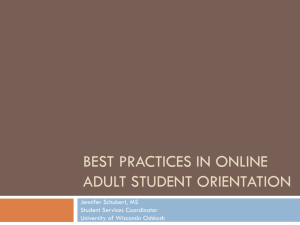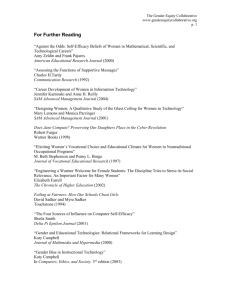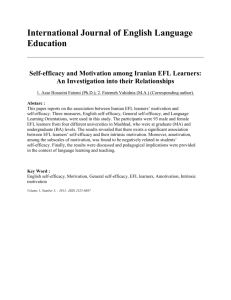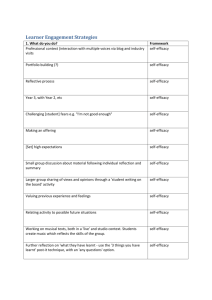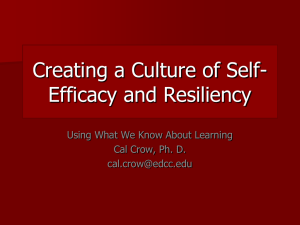Self-Efficacy - Kent State University
advertisement
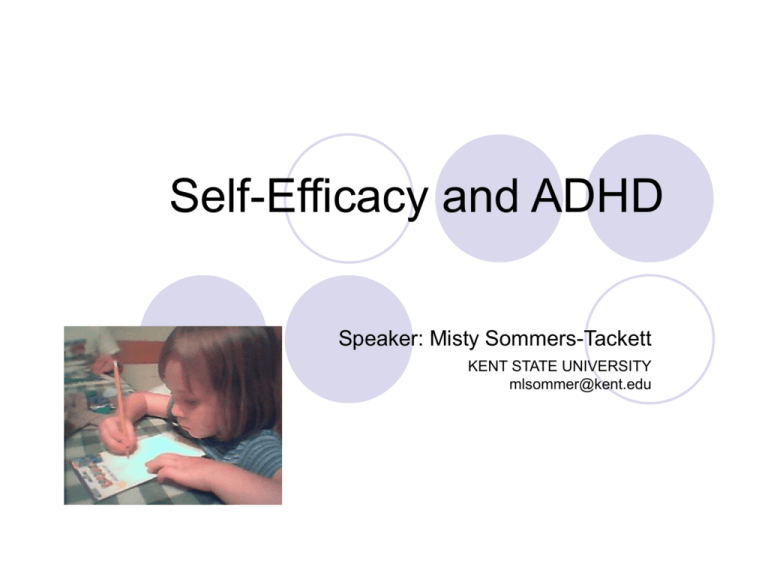
Self-Efficacy and ADHD Speaker: Misty Sommers-Tackett KENT STATE UNIVERSITY mlsommer@kent.edu Self-Efficacy and ADHD What is Self-Efficacy? What is ADHD? How can I use this information?! How are these related? What research says… What is Self-Efficacy? It is the expectation that one can master a situation, and produce a positive outcome Bandura’s Social Cognitive Model says that there are 3 factors that influence selfefficacy: Behaviors, Environment, and personal/cognitive factors. They all effect each other, but the cognitive factors are important. B P/C Bandura believed that there is more to learning than just ‘behaviorism’, what you believe about a situation is important too. E What is ADHD? Disorder that impairs children in learning and social behaviors. Inattention Hyperactivity Comorbid learning disorders Results in a pattern of failures in classroom activities, as well as failures in social relationships. How are these related? Comorbidity with Major Depression. 26 % risk among ADHD children by Young adulthood. Depression is a serious problem due to mortality. ADHD and depression are theorized to have the same genetic predisposition. DSM IV-TR: one feature of a major depressive episode is a sense of worthlessness, or ruminations over past failures. PAST FAILURES?!?! ADHD children have difficulties in both academic and social areas…. **Comorbidity is higher in boys than in girls. How are these related? ***MASTERY EXPERIENCES*** People develop Self Efficacy from 4 main sources: Performance accomplishment Observation of others performance Verbal/Social persuasions Mastery Experiences Concept of Mastery Experiences: if you master one task, there is a better chance of being successful at other similar tasks. (It is important to note here that the mastery experience must be attributed to themselves… not luck, or chance, or others help.) *** If ADHD children are experiencing more failures than others in class due to their disorder symptoms, then won’t their self-efficacy be lower than children without disorders? How are these related? How many of you… Know how to tie your shoe? Know how to speak french? Know how to mix chemicals in the periodic table? Now, how many of you… Would be interested in taking a 2 hour seminar in how to tie your shoes in 12 different ways? Would be interested in 2 semesters of French? Would be interested in taking 8 years of college to become an expert chemist, or to learn how to create liquid crystal inventions? Hmmm…Level of Self-Efficacy + interest = odds of participation? How are these related? The Emotion of interest Four variable directly influence interest: Conflict Complexity Novelty Uncertainty Self-efficacy is directly related to all four of these, so self-efficacy indirectly influences interest through 4 variables… quadratically. Uncertainty plays the biggest role in interest. Self-efficacy affects uncertainty: “How will the activity end up?” If ADHD children have interest in an activity, it leads us to think that they might have a better chance at improving their attention for that activity. What research says… Fuzzy dart test – skill test, try to hit target with dart at various distances. distance was adjusted at varying length for different groups, as well as varying the lengths for another group. interest decreased when it got too easy. those put in the moderate difficulty condition were most interested in repeating the task. those who were placed farthest from the target agreed that it would be more interesting if the line was moved closer to the target. What research says… 7 6 difficulty 5 4 confidence 3 2 interest 1 low moderate high What research says… Self-Efficacy and LD Study Comorbidity and similarity of LD to ADHD. One study compared the self-efficacy of LD students and Normal students, with regards to measures of high or low ability (IQ). In general, those with LD had lower self-efficacy than normal students. Q: If a student has a learning disability, but has a high ability (IQ), would they have a higher self-efficacy? A: This study showed that LD students who had high ability actually had the lowest self-efficacy of all in the study. Why is this? It’s suggested that this is due to the ‘label’ of being LD, but the study did not have evidence of this. So now we know… What Self-Efficacy is… What ADHD is… How they affect each other… What research has to say about it Now I’m sure you are asking yourself How can I use this information?! How can I use this information?! 5 strategies for Enhancing Self-Efficacy Emotional and Physiological arousal Relaxation techniques, calming fears Verbal Persuasion encouragement, convince them success is result of self. Vicarious Experiences observation of modeled behaviors Imagined Experience imagining yourself in the experience Performance Experience actual practice of the activity, “Practice makes perfect!” Maddux (1995) How can I use this information?! WHO can use this information… Educators and Parents Children School Psychologists Discuss ways that people in each of these areas might apply this information to their settings… How can I use this information?! Educators and Parents can use child guided learning: Use suggestions from the child when planning lessons Use interests of children to create ‘centers’ tailored to interests Gauge level of help needed from teacher according to student: Use the Zone of Proximal Development theory from Vygotsky, which says to help students only as it is needed… Exercises that not only encourage learning, but show students success – give them feedback that shows them what they have accomplished… not what they have left to learn. Utilize books and projects created specially for these issues: Publisher Sopris-West has books adapted from the author Louis L’amour that start out exciting and are reading level appropriate.They are revised to help a student feel confident/successful, without embarassing them about reading books for ‘little kids’. How can I use this information?! Suggestions for Children: Concentrate on attributing success to self, not from others. Use tracking logs to observe successes and find interests. Can use logs for numerous issues, such as alertness, behavior, effort… Level of performance Example: Performance Log Time Schedule/Activity 8:00-8:30 am Reading time – read 2 pgs 8:30-9:00 am Math Class – seat work 9:00-9:30 am Math Class – group work Great Good Not so Good X X X RESOURCES All Kinds of Minds, by Mel Levine Books and article links on site: www.allkindsofminds.com Video called “Too much attention” at this link: http://www.allkindsofminds.com/articleDisplay.aspx?articleI D=6&categoryID=0 Books made to help children feel more successful: Sopris-West Products: www.sopriswest.com For those who are interested in research on this topic, these theorists are a good place to start: Vygotsky Bandura James E. Maddux Websites: RESOURCES Children and Adults with Attention Deficit Disorder (CHADD) http://www.chadd.org Council for Learning Disabilities (CLD) http://www.cldinternational.org The Council for Exceptional Children (CEC), Division of Learning Disabilities (DLD) http://www.cec.sped.org All Kinds of Minds, by Dr. Mel Levine http://www.allkindsofminds.com Sopris West Educational Services http://www.sopriswest.com REFERENCES Barkley, R. A., Edwards, G., Laneri, M., Fletcher, K., Metevia, L. (2001) The Efficacy of Problem-Solving Communication Training Alone, Behavior Management Training Alone, and Their Combination for Parent– Adolescent Conflict in Teenagers With ADHD and ODD, Journal of Consulting and Clinical Psychology Volume: 69, Issue: 6, 926-941. Dunn and Shapiro, (1999) Gender Differences in the Achievement Goal Orientations of ADHD children, Cognitive Therapy and Research, 23, No.3, 327-344. J.W. Santrock, (2003) Children, 7th Edition. New York, NY: McGraw Hill. Jacobs, Lanza, Osgood, Eccles, and Wigfield, (2002) Changes in Children’s Self-Competence and Values: Gender and Domain Differences across Grades one through Twelve, Child Development, 73:2, 509-527 Jamner, Henker, Delfino, and Lozano, (2002) The ADHD Spectrum and Everyday Life: Experience Sampling of Adolescent Moods, Activities, Smoking, and Drinking, Whalen, Child Development, Vol 73, No 1, 209-227. Levine, M. (2002). A Mind At A Time. New York: Simon & Schuster. Maddux, J. E. (Ed). (1995). Self-Efficacy, Adaptation, and Adjustment; Theory, Research, and Application. New York: Plenum. Mash, Eric J. and Barkley, Russell A. (2003). Childhood Mood Disorders. In Mash, Eric J. and Barkley, Russell A. Child Psychopathology, Second Edition (pp.233-278). New York, NY: The Guilford Press. Mash, Eric J. and Barkley, Russell A., (2003) Attention-Deficit/Hyperactivity Disorder, In Mash, Eric J. and Barkley, Russell A. Child Psychopathology, Second Edition (pp.75-143). New York, NY: The Guilford Press. Vance, Costin and Maruff , (2002) Attention Deficit Hyperactivity Disorder, combined type (ADHD-CT): differences in blood pressure due to posture and the child report of anxiety, , European Child & Adolescent Psychiatry, 11, 2430. CONTACT ME Questions for Me? Contact me at: mlsommer@kent.edu 330-672-9050 www.mcs.kent.edu/~mtackett/psyc

